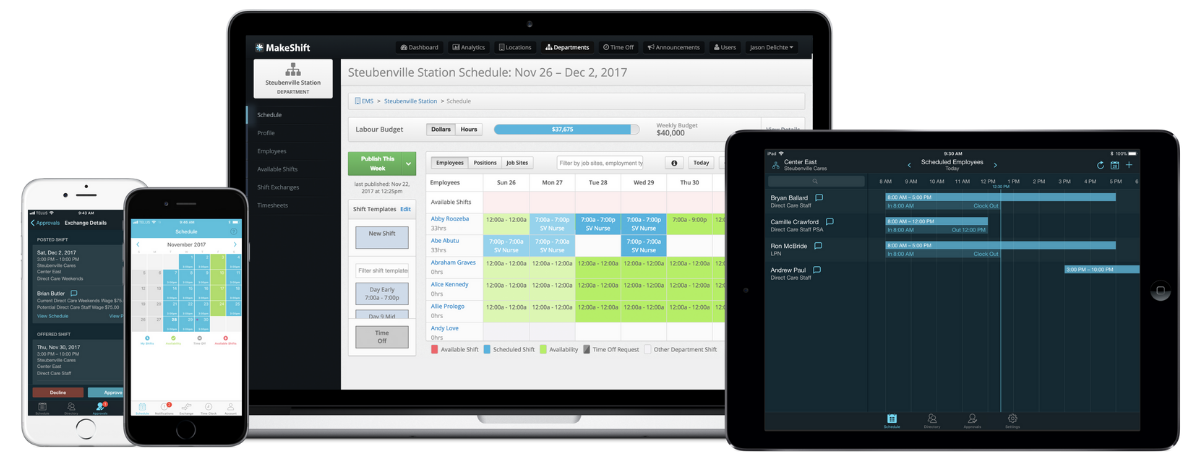Imagine running a high-paced retail store or a bustling restaurant during peak hours with too few employees — or being significantly overstaffed when business is slow.
Either scenario can be costly in terms of customer and employee frustration or unnecessary labor costs.
This is where the art and science of labor forecasting converge.
Labor forecasting connects staffing needs to business demands, creating the ideal balance for productivity, cost control, and employee satisfaction.
While traditional approaches often rely on gut feelings or combing through spreadsheet data, today’s labor forecasting methods use data and smart tech, allowing your business to thrive in an unpredictable environment.
Rising labor costs and compliance regulations only compound the urgency for precise forecasting, especially with growing pressures like rising minimum wages.
Today, we’ll cover 5 ways to achieve the benefits of data-driven scheduling and forecasting staffing needs without the guesswork
- 3 Key Elements of Effective Labor Forecasting
- Align Staffing with Demand
- Optimize Labor Costs
- Improve Employee Experience
- Address Skill Gaps and Optimize the Workforce
- Facilitate Real-Time Adjustments
3 Key Elements of Effective Labor Forecasting
Before diving into our 5 strategies, let’s highlight the 3 main components that make labor forecasting powerful.
Accurate labor forecasting requires a mix of:
1. Historical data — Industry-specific info like:
- Traffic patterns for retail
- Seasonal spikes in patient admissions for healthcare
- Maintenance & outage history for gas and power
2. External factors — Promotions, holidays, and weather for industries like construction
3. Employee metrics — Skillsets, performance, and availability
By combining these factors, forecasting staffing needs becomes a breeze, ensuring the right person is in the right place at the right time.
The 5 strategies below can help to make this happen.
1. Align Staffing with Demand
To create optimized schedules, start by predicting when your business will be bustling or quiet. This allows you to confidently staff up during peak times and scale back during slower periods, ensuring efficiency across your operations.
Use labor forecasting to analyze historical data and identify trends, like holiday rushes or slow weekday afternoons. Plan based on these insights to avoid overwhelming rushes or painfully slow shifts.
When workloads are balanced, employees struggle less with stress, are more engaged, and have higher job satisfaction, contributing to higher retention.
Proper alignment of staffing levels also means sidestepping overstaffing, which drives up labor costs, and understaffing, which can hurt customer service quality. Efficiently aligning staffing to demand helps streamline payroll processes by reducing excess labor costs and minimizing wasted hours.
Make smarter decisions with tech
MakeShift’s predictive analytics simplifies the process of matching staffing to demand. It automatically analyzes historical trends and predicts staffing requirements for upcoming shifts, providing data-driven recommendations.
Features like ShiftPredict ensure you have the right number of employees on hand without spending hours manually adjusting spreadsheets.

Real-time visibility into staffing needs also allows schedule adjustments on the fly as demand changes, ensuring operations are always covered — maximizing efficiency, reducing costs, and enhancing the employee experience.
2. Optimize Labor Costs
Optimize your labor costs using data-driven insights to schedule employees based on anticipated demand. This approach minimizes the chances of unnecessary overtime and overstaffed shifts, ensuring efficient scheduling that directly reduces labor costs.
U.S. contractors reportedly wasted between $30 and $40 billion in 2022 alone due to labor inefficiencies.
Set & forget your labor budget rules
MakeShift’s labor budgets rule feature empowers you to set and monitor labor budgets in real time. MakeShift automatically flags potential scheduling issues before they impact your bottom line.

With budget alerts and real-time cost monitoring, you can instantly identify discrepancies, make necessary adjustments, and keep labor costs aligned with your targets.
3. Improve Employee Experience
Accurate labor forecasting allows you to create schedules that balance business efficiency and employee preferences.
Use a scheduling solution with self-service features to allow staff to set availability, request shift swaps, and view real-time schedules through the mobile app.
Wondering if your team is down for using tech for scheduling? Yep, they are.

Employees are 158% more engaged and 61% more likely to stay in their jobs past the 3-year mark if they’ve got tech that supports them at work.
Incorporate employee preferences, like availability, to create predictable schedules based on labor forecasts that prioritize your people.
By predicting staffing needs based on data, you can roll out consistent, employee-centric schedules that provide predictability. Predictable scheduling helps reduce stress, enhances morale, and improves their overall experience.
Skip the headache & use AI-powered scheduling
MakeShift uses AI-powered labor forecasting to align staffing with anticipated demand, ensuring efficient and employee-friendly schedules.

ShiftMate AI’s suite of generative AI-powered modules helps you optimize your operations for success and employee wellness in a fraction of the time.
This minimizes over and understaffing, leading to more balanced workloads.
4. Address Skill Gaps and Optimize the Workforce
Labor forecasting allows you to anticipate demand and strategically schedule your most skilled employees during peak shifts or critical tasks. This proactive approach helps maintain efficiency and quality and ensures authentic workforce optimization.
Employees are more motivated when they feel their skills are recognized and utilized effectively.
Organizations prioritizing employees’ skills are 98% more likely to retain motivated and high-potential team members.

Labor forecasting enables you to align schedules with employee strengths, giving them more confidence in their roles and minimizing the stress of being assigned tasks outside their skillset.
This type of recognition fosters a sense of value, enhances job satisfaction, and strengthens loyalty.
Skills-based scheduling made easy
MakeShift’s advanced scheduling capabilities ensure that employees with specific skills are placed where they’re most needed, particularly during high-stakes shifts.

Simply ask ShiftMate AI to automatically create schedules that consider labor budgets, skills, compliance, and other constraints — while predicting future demand.
5. Facilitate Real-Time Adjustments
Real-time adjustments are essential for preventing staffing disruptions and maintaining balanced shifts because we all know plans can change in a flash. Use labor forecasting to anticipate high and low-demand periods so you can make smarter, more accurate adjustments when unexpected events arise.
Integrate labor forecasting with scheduling software that offers real-time data and alerts to make on-the-fly staffing level tweaks quick and easy.
Effectively managing real-time adjustments means your employees won't face unpredictable changes that disrupt their work-life balance. Plan future workforce needs using labor forecasting data to prep for demand fluctuations rather than simply reacting when stuff hits the fan.
Quickly address last-minute schedule gaps to keep things moving
MakeShift is committed to accessibility so you can make quick staffing adjustments while considering labor forecasts. It provides instant alerts, ensuring you can modify schedules as needed, while the automatic employee notification system keeps everyone updated on schedule changes through the app.

This proactive approach reduces surprises for employees, helps maintain a well-organized workflow, and ensures operations run smoothly — even when the unexpected happens.
The Bottom Line on Labor Forecasting
Accurate labor forecasting is no longer a luxury — it’s a necessity. Rising labor costs, strict compliance laws, and fluctuating customer demands underscore the need for intuitive, data-driven scheduling.
Labor forecasting supports precise scheduling and profoundly affects employee experience — creating balanced workloads, respecting availability, and ensuring predictable and fair shifts.
Ready to see how MakeShift can make labor forecasting easy? Schedule a FREE demo today.








